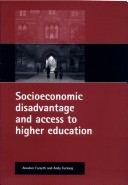Socioeconomic disadvantage and access to higher education argues that the gap in representation in higher education between affluent and disadvantaged young people continues. The research looks at reasons for this, but takes care to distinguish between the factors which qualify young people for higher education and those which predispose them to attend. That is, which factors govern levels of qualification required for entry to higher education and which other factors act as barriers to the progress of disadvantaged young people. Through a survey of school-leavers, before and after leaving school, the report looks at: geographical patterns of academic achievement in relation to indicators of disadvantage; the attrition from full-time education of qualified but disadvantaged young people; the variety of destinations made by disadvantaged school-leavers; patterns and levels of participation in higher and further education; student finance and parental support; barriers to full participation in higher education. - The report concludes with policy recommendations for increasing meaningful participation for under-represented disadvantaged groups of young people which are applicable throughout the UK. Socioeconomic disadvantage and access to higher education is vital reading for policy makers and academics in the fields of education, young people and social exclusion, and anyone interested in higher education and youth transitions. This report should be read alongside Losing out?: Socioeconomic disadvantage and experience in further and higher education (The Policy Press, 2003) also by Alasdair Forsyth and Andy Furlong.
- ISBN10 1861342969
- ISBN13 9781861342966
- Publish Date 28 November 2000
- Publish Status Out of Print
- Out of Print 26 April 2011
- Publish Country GB
- Imprint Policy Press
- Format Paperback
- Pages 64
- Language English
